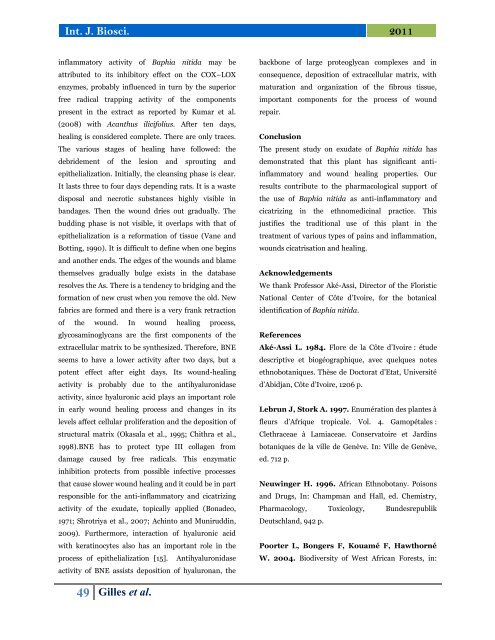Anti-inflammatory and cicatrizing activity of Baphia nitida Lodd. exudates
Abstract Baphia nitida exudate (BNE) is used in folk medicine for the treatment inflammation and cicatrisation of wounds in Côte d’Ivoire. BNE was formulated into an ointment and tested at two dose levels for anti-inflammatory and cicatrizing activity against excision wounds created on dorsal areas of rats. Both provide evidence for the ability of BNE to inhibit the inflammatory condition and to accelerate wound cicatrization on the rats. The activity was found to be dose related, and BNE at 2% was found to be best dose for the two tests used. Phenylbutazone cream used as a positive control reference was significantly active in both systems. These results provide a scientific basis for the traditional use of the exudate of Baphia nitida as an anti-inflammatory and cicatrizing agent.
Abstract
Baphia nitida exudate (BNE) is used in folk medicine for the treatment inflammation and cicatrisation of wounds in Côte d’Ivoire. BNE was formulated into an ointment and tested at two dose levels for anti-inflammatory and cicatrizing activity against excision wounds created on dorsal areas of rats. Both provide evidence for the ability of BNE to inhibit the inflammatory condition and to accelerate wound cicatrization on the rats. The activity was found to be dose related, and BNE at 2% was found to be best dose for the two tests used. Phenylbutazone cream used as a positive control reference was significantly active in both systems. These results provide a scientific basis for the traditional use of the exudate of Baphia nitida as an anti-inflammatory and cicatrizing agent.
You also want an ePaper? Increase the reach of your titles
YUMPU automatically turns print PDFs into web optimized ePapers that Google loves.
Int. J. Biosci. 2011<br />
<strong>inflammatory</strong> <strong>activity</strong> <strong>of</strong> <strong>Baphia</strong> <strong>nitida</strong> may be<br />
attributed to its inhibitory effect on the COX–LOX<br />
enzymes, probably influenced in turn by the superior<br />
free radical trapping <strong>activity</strong> <strong>of</strong> the components<br />
present in the extract as reported by Kumar et al.<br />
(2008) with Acanthus ilicifolius. After ten days,<br />
healing is considered complete. There are only traces.<br />
The various stages <strong>of</strong> healing have followed: the<br />
debridement <strong>of</strong> the lesion <strong>and</strong> sprouting <strong>and</strong><br />
epithelialization. Initially, the cleansing phase is clear.<br />
It lasts three to four days depending rats. It is a waste<br />
disposal <strong>and</strong> necrotic substances highly visible in<br />
b<strong>and</strong>ages. Then the wound dries out gradually. The<br />
budding phase is not visible, it overlaps with that <strong>of</strong><br />
epithelialization is a reformation <strong>of</strong> tissue (Vane <strong>and</strong><br />
Botting, 1990). It is difficult to define when one begins<br />
<strong>and</strong> another ends. The edges <strong>of</strong> the wounds <strong>and</strong> blame<br />
themselves gradually bulge exists in the database<br />
resolves the As. There is a tendency to bridging <strong>and</strong> the<br />
formation <strong>of</strong> new crust when you remove the old. New<br />
fabrics are formed <strong>and</strong> there is a very frank retraction<br />
<strong>of</strong> the wound. In wound healing process,<br />
glycosaminoglycans are the first components <strong>of</strong> the<br />
extracellular matrix to be synthesized. Therefore, BNE<br />
seems to have a lower <strong>activity</strong> after two days, but a<br />
potent effect after eight days. Its wound-healing<br />
<strong>activity</strong> is probably due to the antihyaluronidase<br />
<strong>activity</strong>, since hyaluronic acid plays an important role<br />
in early wound healing process <strong>and</strong> changes in its<br />
levels affect cellular proliferation <strong>and</strong> the deposition <strong>of</strong><br />
structural matrix (Okasala et al., 1995; Chithra et al.,<br />
1998).BNE has to protect type III collagen from<br />
damage caused by free radicals. This enzymatic<br />
inhibition protects from possible infective processes<br />
that cause slower wound healing <strong>and</strong> it could be in part<br />
responsible for the anti-<strong>inflammatory</strong> <strong>and</strong> <strong>cicatrizing</strong><br />
<strong>activity</strong> <strong>of</strong> the exudate, topically applied (Bonadeo,<br />
1971; Shrotriya et al., 2007; Achinto <strong>and</strong> Muniruddin,<br />
2009). Furthermore, interaction <strong>of</strong> hyaluronic acid<br />
with keratinocytes also has an important role in the<br />
process <strong>of</strong> epithelialization [15]. <strong>Anti</strong>hyaluronidase<br />
<strong>activity</strong> <strong>of</strong> BNE assists deposition <strong>of</strong> hyaluronan, the<br />
backbone <strong>of</strong> large proteoglycan complexes <strong>and</strong> in<br />
consequence, deposition <strong>of</strong> extracellular matrix, with<br />
maturation <strong>and</strong> organization <strong>of</strong> the fibrous tissue,<br />
important components for the process <strong>of</strong> wound<br />
repair.<br />
Conclusion<br />
The present study on exudate <strong>of</strong> <strong>Baphia</strong> <strong>nitida</strong> has<br />
demonstrated that this plant has significant anti<strong>inflammatory</strong><br />
<strong>and</strong> wound healing properties. Our<br />
results contribute to the pharmacological support <strong>of</strong><br />
the use <strong>of</strong> <strong>Baphia</strong> <strong>nitida</strong> as anti-<strong>inflammatory</strong> <strong>and</strong><br />
<strong>cicatrizing</strong> in the ethnomedicinal practice. This<br />
justifies the traditional use <strong>of</strong> this plant in the<br />
treatment <strong>of</strong> various types <strong>of</strong> pains <strong>and</strong> inflammation,<br />
wounds cicatrisation <strong>and</strong> healing.<br />
Acknowledgements<br />
We thank Pr<strong>of</strong>essor Aké-Assi, Director <strong>of</strong> the Floristic<br />
National Center <strong>of</strong> Côte d’Ivoire, for the botanical<br />
identification <strong>of</strong> <strong>Baphia</strong> <strong>nitida</strong>.<br />
References<br />
Aké-Assi L. 1984. Flore de la Côte d’Ivoire : étude<br />
descriptive et biogéographique, avec quelques notes<br />
ethnobotaniques. Thèse de Doctorat d’Etat, Université<br />
d’Abidjan, Côte d’Ivoire, 1206 p.<br />
Lebrun J, Stork A. 1997. Enumération des plantes à<br />
fleurs d’Afrique tropicale. Vol. 4. Gamopétales :<br />
Clethraceae à Lamiaceae. Conservatoire et Jardins<br />
botaniques de la ville de Genève. In: Ville de Genève,<br />
ed. 712 p.<br />
Neuwinger H. 1996. African Ethnobotany. Poisons<br />
<strong>and</strong> Drugs, In: Champman <strong>and</strong> Hall, ed. Chemistry,<br />
Pharmacology, Toxicology, Bundesrepublik<br />
Deutschl<strong>and</strong>, 942 p.<br />
Poorter L, Bongers F, Kouamé F, Hawthorné<br />
W. 2004. Biodiversity <strong>of</strong> West African Forests, in:<br />
49 Gilles et al.





![Review on: impact of seed rates and method of sowing on yield and yield related traits of Teff [Eragrostis teff (Zucc.) Trotter] | IJAAR @yumpu](https://documents.yumpu.com/000/066/025/853/c0a2f1eefa2ed71422e741fbc2b37a5fd6200cb1/6b7767675149533469736965546e4c6a4e57325054773d3d/4f6e6531383245617a537a49397878747846574858513d3d.jpg?AWSAccessKeyId=AKIAICNEWSPSEKTJ5M3Q&Expires=1716609600&Signature=MAbcqnRqhZSyrd3KTLU11wtEiL0%3D)












